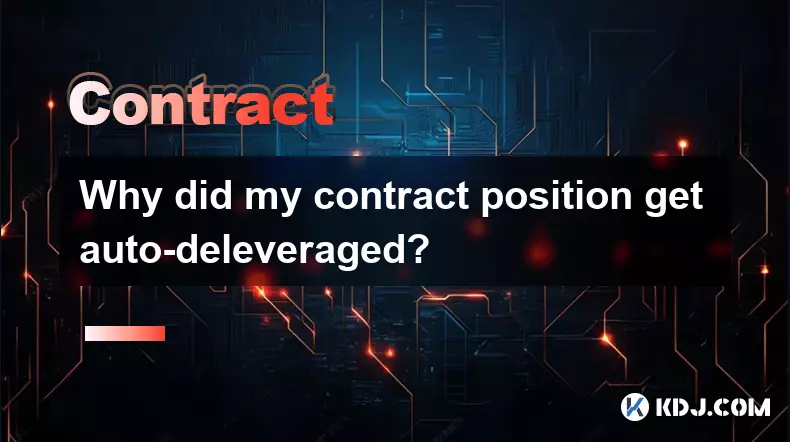-
 bitcoin
bitcoin $105968.894684 USD
4.17% -
 ethereum
ethereum $3639.320047 USD
7.62% -
 tether
tether $1.000339 USD
0.06% -
 xrp
xrp $2.407774 USD
5.96% -
 bnb
bnb $1011.704193 USD
2.28% -
 solana
solana $166.942754 USD
6.37% -
 usd-coin
usd-coin $1.000143 USD
0.03% -
 tron
tron $0.291515 USD
0.25% -
 dogecoin
dogecoin $0.181682 USD
4.06% -
 cardano
cardano $0.585450 USD
4.54% -
 hyperliquid
hyperliquid $42.099968 USD
5.20% -
 chainlink
chainlink $16.160745 USD
5.45% -
 zcash
zcash $645.269648 USD
12.96% -
 bitcoin-cash
bitcoin-cash $507.430338 USD
2.80% -
 stellar
stellar $0.290357 USD
3.69%
Why did my contract position get auto-deleveraged?
Auto-deleveraging forces profitable traders to cover others' losses during extreme volatility, especially on platforms with shared risk models and high leverage.
Nov 06, 2025 at 01:09 pm

Understanding Auto-Deleveraging in Crypto Derivatives
1. In the volatile world of cryptocurrency derivatives, auto-deleveraging is a mechanism employed by certain exchanges to manage risk when traders use high leverage. When a trader’s position can no longer be sustained due to adverse price movements and their margin balance falls below maintenance requirements, the system initiates liquidation. However, if there are insufficient funds in the insurance pool or the market lacks liquidity to absorb the loss, the exchange may resort to auto-deleveraging.
2. This process directly affects other traders who hold opposing positions. The exchange forcibly closes profitable positions to cover the losses of the insolvent trader. It typically targets those with the highest profitability and available leverage capacity. As a result, even disciplined traders with strong risk management may see their winning positions closed without warning.
3. Auto-deleveraging occurs more frequently during periods of extreme volatility. Sharp price swings, often triggered by macroeconomic news or large on-chain transactions, can lead to cascading liquidations. Exchanges relying on peer-to-peer or mutualized risk models are especially prone to this mechanism because liabilities are shared among active traders rather than being absorbed solely by the platform.
4. Traders must recognize that using maximum leverage increases their exposure not only to market risk but also to systemic risk introduced by the exchange's architecture. Platforms advertising zero fees or deep liquidity might offset these advantages through aggressive risk-sharing protocols like auto-deleveraging.
Key Factors That Trigger Position Closure
1. Insufficient isolated margin relative to position size is one of the primary causes. When trading with isolated margin, the allocated capital acts as a buffer. If the price moves against the position beyond that buffer, liquidation follows swiftly. Many users underestimate how quickly funding rates and price gaps erode small margin allocations.
2. Extreme market volatility causing price slippage can trigger automatic deleveraging even before stop-loss orders execute. During flash crashes or rapid rallies, order books thin out, making it impossible for the system to close positions at expected prices. This mismatch forces the exchange to escalate to auto-deleveraging protocols.
3. Holding positions during major news events such as regulatory announcements, protocol upgrades, or macroeconomic data releases significantly raises the likelihood of unexpected closures. These moments often coincide with reduced market depth and widened spreads, amplifying execution risks.
4. Using platforms with opaque risk engines means traders cannot accurately predict when or how deleveraging will occur. Some exchanges publish tiered liquidation tables, while others keep their methodologies hidden, leaving users vulnerable to sudden equity loss without prior notice.
Risk Mitigation Strategies for Leveraged Trading
1. Maintaining conservative leverage ratios—such as capping usage at 5x or lower—reduces susceptibility to abrupt liquidation. Even experienced traders find it difficult to anticipate black swan events; lower leverage provides breathing room during unforeseen volatility spikes.
2. Diversifying across multiple exchanges helps avoid concentration risk tied to specific platform mechanics. Each exchange implements auto-deleveraging differently. By spreading activity, traders reduce dependency on any single venue’s risk model.
3. Monitoring open interest and funding rates offers insight into market sentiment and potential squeeze conditions. Sudden spikes in long/short ratios or extreme positive/negative funding can signal an environment where auto-deleveraging becomes more likely.
4. Setting up external alerts for price levels, volume changes, and blockchain metrics allows for proactive position management. Relying solely on exchange-provided tools may result in delayed responses, especially during server overloads common in high-volatility periods.
Frequently Asked Questions
What determines the order of auto-deleveraging?
Exchanges typically prioritize traders based on profitability and leverage used. Those with the largest unrealized gains and higher effective leverage are targeted first. The exact algorithm varies by platform but generally aims to minimize overall system impact while covering the shortfall from the defaulted position.
Can I avoid auto-deleveraging entirely?
Avoidance is possible by trading on centralized exchanges that absorb losses internally using proprietary risk reserves instead of mutualizing them among users. Additionally, opting for cross-margin systems with sufficient buffer capital or switching to non-leveraged spot trading eliminates exposure to this mechanism.
Does auto-deleveraging affect all contract types equally?
No. Perpetual contracts with funding mechanisms are more susceptible due to continuous settlement and reliance on market balance. Quarterly futures or options contracts settle less frequently and often have clearer risk boundaries, reducing the need for real-time deleveraging interventions.
Are there transparency standards for auto-deleveraging events?
Currently, no universal standards exist. Some platforms publish post-event reports detailing affected accounts and recovery calculations, while others provide minimal disclosure. Traders should review each exchange’s terms of service and historical incident logs before committing capital.
Disclaimer:info@kdj.com
The information provided is not trading advice. kdj.com does not assume any responsibility for any investments made based on the information provided in this article. Cryptocurrencies are highly volatile and it is highly recommended that you invest with caution after thorough research!
If you believe that the content used on this website infringes your copyright, please contact us immediately (info@kdj.com) and we will delete it promptly.
- XRP: Is This Crypto's Best-Performing Asset?
- 2025-11-11 06:45:01
- Navigating the Crypto Maze: Economic Schedules, Treasury Auctions, and the Bitcoin Beacon
- 2025-11-11 07:40:01
- AVAX & OP: Price Prediction, Open Interest, and Recovery Gains - What's Next?
- 2025-11-11 06:50:02
- Mantle, Anchorage Digital, and Institutional Custody: Bridging TradFi and DeFi
- 2025-11-11 05:20:01
- XRP ETF Hype and Remittix Rise: Navigating the Evolving Crypto Landscape
- 2025-11-11 05:25:01
- UK Stablecoin Regulation: A Pivotal Step Forward?
- 2025-11-11 05:05:01
Related knowledge

What is a Denial of Service (DoS) attack in a smart contract and what are its common forms?
Nov 10,2025 at 05:20am
Understanding Denial of Service in Smart Contracts1. A Denial of Service (DoS) attack in the context of smart contracts refers to a scenario where a m...

What is a cryptographic nonce used for in transaction signing?
Nov 11,2025 at 05:59am
Understanding Cryptographic Nonces in Blockchain Transactions1. A cryptographic nonce is a random or pseudo-random number used only once in the contex...

How do you safely send Ether to another contract?
Nov 09,2025 at 06:40pm
Sending Ether to Smart Contracts: Key Considerations1. Verify that the receiving contract has a payable fallback function or a designated payable func...

What is the role of a block timestamp and what are its limitations for security?
Nov 11,2025 at 02:19am
Understanding the Role of Block Timestamps in Blockchain Networks1. A block timestamp serves as a chronological marker indicating when a particular bl...

What is a state machine and how can a contract be designed as one?
Nov 08,2025 at 02:19pm
Understanding State Machines in Blockchain Context1. A state machine is a computational model used to design systems that transition between defined s...

How does a bonding curve work and how is it used for token sales?
Nov 09,2025 at 04:00pm
Understanding the Mechanics of Bonding Curves1. A bonding curve is a mathematical function that links the price of a token to its supply. As more toke...

What is a Denial of Service (DoS) attack in a smart contract and what are its common forms?
Nov 10,2025 at 05:20am
Understanding Denial of Service in Smart Contracts1. A Denial of Service (DoS) attack in the context of smart contracts refers to a scenario where a m...

What is a cryptographic nonce used for in transaction signing?
Nov 11,2025 at 05:59am
Understanding Cryptographic Nonces in Blockchain Transactions1. A cryptographic nonce is a random or pseudo-random number used only once in the contex...

How do you safely send Ether to another contract?
Nov 09,2025 at 06:40pm
Sending Ether to Smart Contracts: Key Considerations1. Verify that the receiving contract has a payable fallback function or a designated payable func...

What is the role of a block timestamp and what are its limitations for security?
Nov 11,2025 at 02:19am
Understanding the Role of Block Timestamps in Blockchain Networks1. A block timestamp serves as a chronological marker indicating when a particular bl...

What is a state machine and how can a contract be designed as one?
Nov 08,2025 at 02:19pm
Understanding State Machines in Blockchain Context1. A state machine is a computational model used to design systems that transition between defined s...

How does a bonding curve work and how is it used for token sales?
Nov 09,2025 at 04:00pm
Understanding the Mechanics of Bonding Curves1. A bonding curve is a mathematical function that links the price of a token to its supply. As more toke...
See all articles























![🔥 Long awaited! The ancestor of Pi coin is about to take off? PI friends, come in and take a look! [Daily Coin Selection | Bitcoin Trend | Money Making Opportunities] 🔥 Long awaited! The ancestor of Pi coin is about to take off? PI friends, come in and take a look! [Daily Coin Selection | Bitcoin Trend | Money Making Opportunities]](/uploads/2025/11/10/cryptocurrencies-news/videos/6911e42f9bad7_image_500_375.webp)


















































